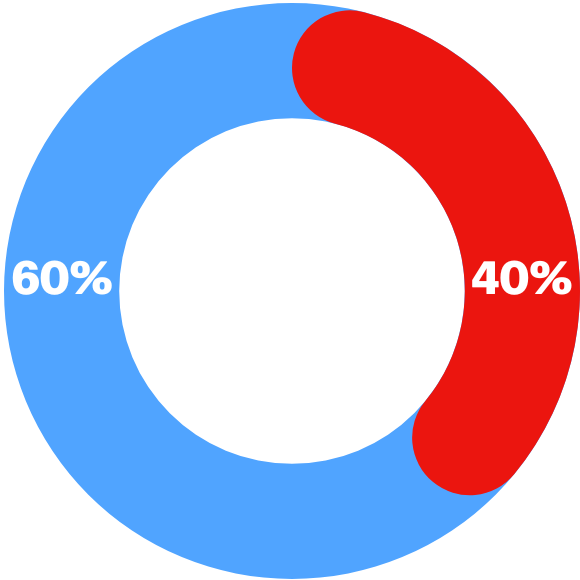Guide to an Effective Recruitment Process
Organisations can lose out on hiring top talent or make rushed hiring decisions if they don't have an efficient recruitment process.

A solid recruitment strategy with clearly defined steps is essential for attracting, screening, and onboarding the best candidates for your company.
In this comprehensive guide, we’ll walk human resources teams and hiring managers through the key phases of an effective recruitment process. Follow these 7 steps, and you’ll be well on your way to building an all-star team.
Benefits of a solid recruiting process
Hiring new employees is crucial for companies to succeed. But recruiting an unqualified person can be costly. An effective recruitment process helps find candidates who are a great match. Here are some major benefits of taking the time to create a strategic recruiting process.
Saves time and money
A strong process upfront saves effort later on. Carefully screening job seekers and interviewing thoughtfully avoids wasted time with not qualified candidates.
Hiring the right person the first time also prevents costs of turnover if the wrong hire doesn’t work out. A good process reduces spending on advertising and agency fees to fill the role again.
Results in quality candidates
Thoughtful recruiting means finding great candidates that perfectly fit the role and company culture. Their skills and experience align with the position’s needs.
Evaluate candidates based on clear criteria, not “gut feelings”. Consistent assessment identifies top applicants ready to excel in the job.

Strengthens employer brand
A positive recruitment experience reflects well on the company. Even applicants not selected will come away with a good impression.
When recruitment is organised and professional, it boosts the company’s reputation and employer brand. Top candidates are more likely to accept offers from companies with strong brands.
Enhances diversity
An effective process encourages diversity. Share job postings across diverse channels to reach less represented groups.
Removing bias from assessments provides equal opportunity. Consider diversity when sourcing and selecting to build a well-rounded team.
Investing in a strategic recruitment process offers major dividends through better hires. It takes work upfront, but the benefits are well worth it.

Recruitment process key steps
Step 1: Identify hiring needs
Thoughtfully evaluating your staffing needs is the critical first step. Review upcoming projects and workloads across departments. Pinpoint where gaps exist or additional hiring may be beneficial. Consider if you can redistribute existing employee responsibilities before hiring someone new.
When you decide to fill a vacancy, list the requirements for the role and get approval for the budget. Taking time upfront to fully assess needs enables you to design an optimal recruitment process plan.
According to the Australian Bureau of Statistics (ABS), the unemployment rate in Australia was 3.7%, based on Aug. 2023 statistics.
Review current and upcoming openings
Meet with your team to discuss openings. This may include:
- Filling roles soon to be vacant because of retirement or resignation
- Adding headcount to better manage the increasing workload
- Expanding into new markets or launching new products
For each opening, think about:
- Is this a replacement or a net new role?
- What are the required skills and experience?
- What traits fit your company culture?
Set your budget and timeframe
Determine the salary range and hiring timeline for each open position. Factor in:
- Salary, benefits, potential bonuses or relocation assistance
- Number of weeks to source, screen and interview candidates
Create a calendar with target dates for each hiring task. This keeps the process moving forward.
Step 2: Write the job description

Well-crafted job descriptions attract suitable applicants. Research the position’s core duties and required skill set. Outline the job title, role, department, job responsibilities, and must-have hard and soft skills.
Specify the necessary experience level, education, certifications, and technical abilities sought. Describe the work schedule, salary band, benefits, and other helpful context.
Tailor the description to the specifics of the role and your working environment. Thoroughly detailing the position will guide potential candidates on whether they’re a good match.
67% of organisations include diversity and inclusion in their job descriptions, according to a survey by AHRI.
Follow these best practices when writing effective role profiles.
- Highlight Company Culture
- Focus on Required Skills
- Use Clear Language
- Showcase Career Growth
- Highlight Benefits
- Review Regularly
Crafting detailed yet concise job descriptions allows organisations to connect with the right candidates. Following best practices enhances recruitment efforts and hiring outcomes.
Step 3: Post the job ad
Cast a wide net when publicising openings to reach qualified candidates. Post on your careers page and leading job boards.
Promote on social media channels and in email newsletters. Connect with professional associations and industry groups to share with their membership. Attend relevant events and conferences to network.
Consider employee referrals and existing talent pools like previous applicants or contractors. The broader your outreach, the stronger your applicant pool will be.
Crafting an effective job advertisement
A well-written job advertisement is a critical step in recruiting top talent. The job post is often the first impression candidates have of your company. Make sure it accurately portrays the role and attracts qualified applicants.
- Describe the Job Responsibilities
- Specify Required Skills
- Highlight Preferred Credentials
- Share Company Culture and Values
- List Salary and Benefits
- Explain the Application Process
- Sell Your Company and Role
Read How to Write An Effective Job Advertisement
Step 4: Screen applications

Once the applications start rolling in, it’s time to separate the wheat from the chaff.
Thoroughly yet efficiently review each resume and cover letter. Look for candidates whose skills and experience closely align with the job description. Eliminate applicants who don’t meet the minimum skill set.
As you identify promising applicants, flag them for phone screens. This is an initial filtering step to verify interest and assess communication skills before investing time into a full job interview.
After phone screens, decide who to bring in for one-on-one or panel interviews. You don’t want to waste team members’ time interviewing unqualified candidates.
Experts recommend screening involves techniques like reviewing CVs/resumes, conducting interviews, giving assessments and checking references. Screening helps identify the most qualified applicants.
How to effectively screen job applicants
- Review Resumes Against Required Skills and Experience
- Conduct Phone or Video Interviews
- Give Online Assessments
- Check References
Step 5: Interview candidates
Interviews allow you to truly assess candidates’ technical abilities, critical thinking, and cultural fit.
Come prepared with a structured interview guide that includes behavioural and specific questions. Look for examples of when they’ve successfully navigated relevant projects or challenges.
Panel interviews that include future peers allow candidates to meet potential team members. It also provides multiple perspectives to determine if the candidate would be a good match.
Take thorough notes during interviews so you can compare the strengths and weaknesses of the applicants. When you spot warning signs, determine if they’re critical enough to stop the hiring or if coaching can solve them.
Research shows the selection process aims to identify the best candidates through interviews, assessments, and other selection methods. Conducting organised, consistent interviews is key.
How to conduct job interviews
- Prepare Interview Questions in Advance
- Start with an Icebreaker
- Discuss the Candidate’s Background
- Ask Behavioral Interview Questions
- Close with Time for Candidate Questions
Step 6: Make a job offer
Once you’ve identified the standout finalist(s), it’s time to seal the deal. Refrain from making an official offer hastily.
First, conduct reference checks to validate past managers’ experiences working with the candidate. Then make a verbal offer contingent upon a background check coming back favorably.
Providing a verbal offer allows you to confirm the candidate is truly interested before completing the paperwork. If they verbally accept, send a formal written offer letter detailing compensation, benefits, and any contingencies.
Leave room for negotiation and give the candidate at least a week to thoroughly review the offer with their family. This shows respect for their decision process.
Experts emphasise making a solid offer that clearly outlines the terms. This gives the candidate confidence in accepting the role.
Effective steps for making a hiring decision
- Define Your Ideal Candidate Profile
- Standardise and Score the Interview Process
- Check References Thoroughly
- Review with Other Decision Makers
- Make a Timely Decision
- Set Clear Expectations
Step 7: Onboard the new hire
Start by announcing the hire to the broader team. Prepare the new hire’s desk and equipment for their first day. Give the new hire manuals, login credentials, and tools they need to start working.
Schedule onboarding meetings with leadership, their manager, and key cross-functional partners. Create a ramp-up plan listing activities and training for their first 90 days.
Check in regularly to see how they’re adjusting and address any blockers early on. Investing in thorough onboarding leads to higher engagement, productivity, and retention.
Research shows that an effective onboarding process is crucial to integrate new employees and make them productive quickly. This sets them up for success.
Download: 7 Essential recruitment steps with stats every HR pro should know
The role of technology in recruitment process
Technology has transformed nearly every aspect of business, and recruiting is no exception. Advanced tools and platforms are changing how organisations source, engage, assess and hire new talent.
Streamlining processes
In the past, recruiting was largely manual and paper-based. Job openings are in newspapers, received physical resumes from candidates, and conducted face-to-face interviews. Today’s technologies automate time-consuming tasks like recruitment software, scheduling interviews, and communicating with applicants.
Applicant tracking systems (ATS) centralise the hiring process in one digital platform. Recruiters can post job ads, receive and screen submissions, and advance candidates through the different stages. Features like AI-enabled resume parsing and two-way texting further simplify recruitment strategy.
Accessing new pools of candidates
Technology expands the talent pool available to employers. Social platforms like LinkedIn provide access to millions of passive candidates not actively job searching. Employer branding on sites like Glassdoor helps attract candidates aligned with company values.
Sourcing tools scrape the web to find publicly available profiles and contact info. Programmatic job advertising uses data to determine optimal channels and times to reach relevant candidates.
Enhancing candidate experience
The rise of consumer-focused internet companies has led candidates to expect seamless digital experiences. Employers are using technology to engage talent and build their brands as employers.
User-friendly career sites, one-click applications, and regular communication create positive experiences. Chatbots handle common applicant questions to reduce response times. On-boarding portals guide new hires through paperwork and getting up to speed.
Assessing and selecting talent
Technology is assisting recruiters in evaluating applicants. Pre-employment testing platforms allow customised assessments of skills, aptitude, and culture fit.
According to a report by PwC, 40% of Australian HR professionals are already using AI and automation in their recruitment processes. This trend is expected to continue, with more companies adopting AI-powered tools to streamline their recruitment processes and improve candidate experience.
Video interviewing makes it easier to screen candidates remotely. Analytics help remove bias by analysing trends in hiring decisions. The data can highlight areas for improvement in finding and selecting the best people.

Download: A Simple Checklist for Effective Recruitment
Key takeaways
Following a structured recruitment process allows you to efficiently build a stellar team. Invest time upfront planning hiring needs, developing criteria, attracting quality applicants, carefully screening candidates, interviewing thoughtfully, and onboarding new employees.
Adapting this process to the hybrid work era is crucial. Using key steps and best practices leads to hiring and retaining the talent you need to move your organisation forward. With an empowering, optimistic approach, you can master recruitment and gain top talent.
Recruiting top talent takes time, but it’s one of the most worthwhile investments your company can make. Following this structured 7-step recruitment process will help you source, assess, and hire candidates who’ll drive innovation and growth.
 HR Core
HR Core 









